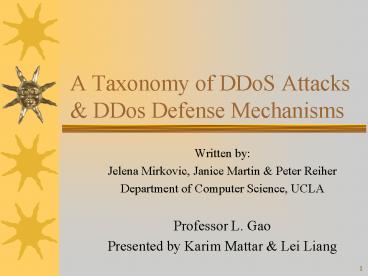A Taxonomy of DDoS Attacks - PowerPoint PPT Presentation
1 / 14
Title:
A Taxonomy of DDoS Attacks
Description:
Uses information on the compromised host (Email worms) Permutation scanning ... Autonomous propagation (Code Red, Warhol & Email Worms) ... – PowerPoint PPT presentation
Number of Views:73
Avg rating:3.0/5.0
Title: A Taxonomy of DDoS Attacks
1
A Taxonomy of DDoS Attacks DDos Defense
Mechanisms
- Written by
- Jelena Mirkovic, Janice Martin Peter Reiher
- Department of Computer Science, UCLA
- Professor L. Gao
- Presented by Karim Mattar Lei Liang
2
Overview of the Paper
- Part 1 Proposes a taxonomy of distributed
denial-of-service attacks - Part 2 Proposes a taxonomy of defense mechanisms
to counter these attacks
3
What is a DDos Attack?
- DoS attacks attempt to prevent legitimate users
of a service from using it - Examples of DoS include
- Flooding a network
- Disrupting connections between machines
- Disrupting a service
- Distributed Denial-of-Service Attacks imply
that many machines are involved in the attack
against one or more victim(s).
4
DDos Modes of Attack
- Consumption of scare resources
- Network connectivity (SYN flooding)
- Bandwidth consumption (Flooding of ICMP packets)
- Consumption of Memory, disk space or data
structures - Destruction or alteration of configuration files
- Physical destruction or alteration of network
components
5
What Makes DDoS Attacks Possible?
- Internet was designed with functionality not
security in mind - Internet security is highly interdependent
- Internet resources are limited
- Power of many is greater than power of a few
6
DDoS Attack Strategy
- Automatically scan remote machines to identify
vulnerable ones - Infect vulnerable machines with the attack code
- Infected machines are used for further
recruitment of new agents (slaves)
7
Goal of DDoS Attacks
- The main goal of DDoS attacks is to inflict
damage for one of the following reasons - Personal reasons (revenge)
- Material gain
- Popularity in the hacker community
8
Classification By Degree of Automation
- Manual attacks
- Semi-Automatic attacks
- Direct communication
- Master slave know each others identity
- Indirect Communication
- Use IRC channels to communicate
- Automatic Attacks
- Attacker is only involved in issuing a single
command
9
Classification by Scanning Strategy
- Random scanning
- Probes random addresses in the IP address space
(CRv2) - Hitlist scanning
- Probes addresses from an externally supplied list
- Topological scanning
- Uses information on the compromised host (Email
worms) - Permutation scanning
- Uses a pseudo-random permutation of the IP
address space (Not yet deployed) - Local subnet scanning
- Preferentially scans targets that reside on the
same subnet as the compromised host. (Code Red II
Nimda Worm)
10
Classification by Propagation Mechanism
- Central source propagation (li0n Worm)
- Attack code resides on central server(s)
- Back-chaining propagation (Ramen Morris Worms)
- Attack code is downloaded from the machine that
was used to exploit the system - Avoids a single point of failure
- Autonomous propagation (Code Red, Warhol Email
Worms) - Attack code is directly injected into the target
host during the exploitation phase
11
Classification by Exploited Vulnerability
- Protocol attacks
- TCP SYN attack
- CGI request attack
- Authentication server attack
- Brute-force attacks
- Filterable attacks
- UDP flood attack
- ICMP request flood attack on a web server
- Non-filterable attacks
- HTTP request
- DNS request
12
Classification by Attack Rate Dynamics
- Continuous attack rates
- Sometimes suffers from fast detection
- Variable attack rates
- Increasing rate attacks
- Slow exhaustion of victims resources
- Delays detection of the attack
- Fluctuating rate attacks
- Adjusts the rate of the attack based on the
victims behavior or response to avoid detection
13
Classification by Impact
- Disruptive attacks
- Completely deny the victims service to its
clients - Degrading attacks
- Goal is to consume some portion of the victims
resources - Could remain undetected for a very long time
14
End of Part I
- Any Questions?































